Leiden, UB, BPL 139B
What’s inside?1
The modern cardboard binding of Leiden UB, BPL 139B hides three sets of logical texts, all made around the same period (the late tenth or early eleventh century) The first part (ff. 1-31) includes various works of the monk Abbo of Fleury, including his De syllogismis categoricis and his De syllogismis hypotheticis. The second part (ff. 32-39) is a copy of the Peri hermenias, attributed to the late-antique writer Apuleius. The third part consists of Boethius’s translation of the Isagoge of Porphyry (ff. 40-46). The manuscript unites, therefore, (medieval) contemporary and classical views on logic into one collection.
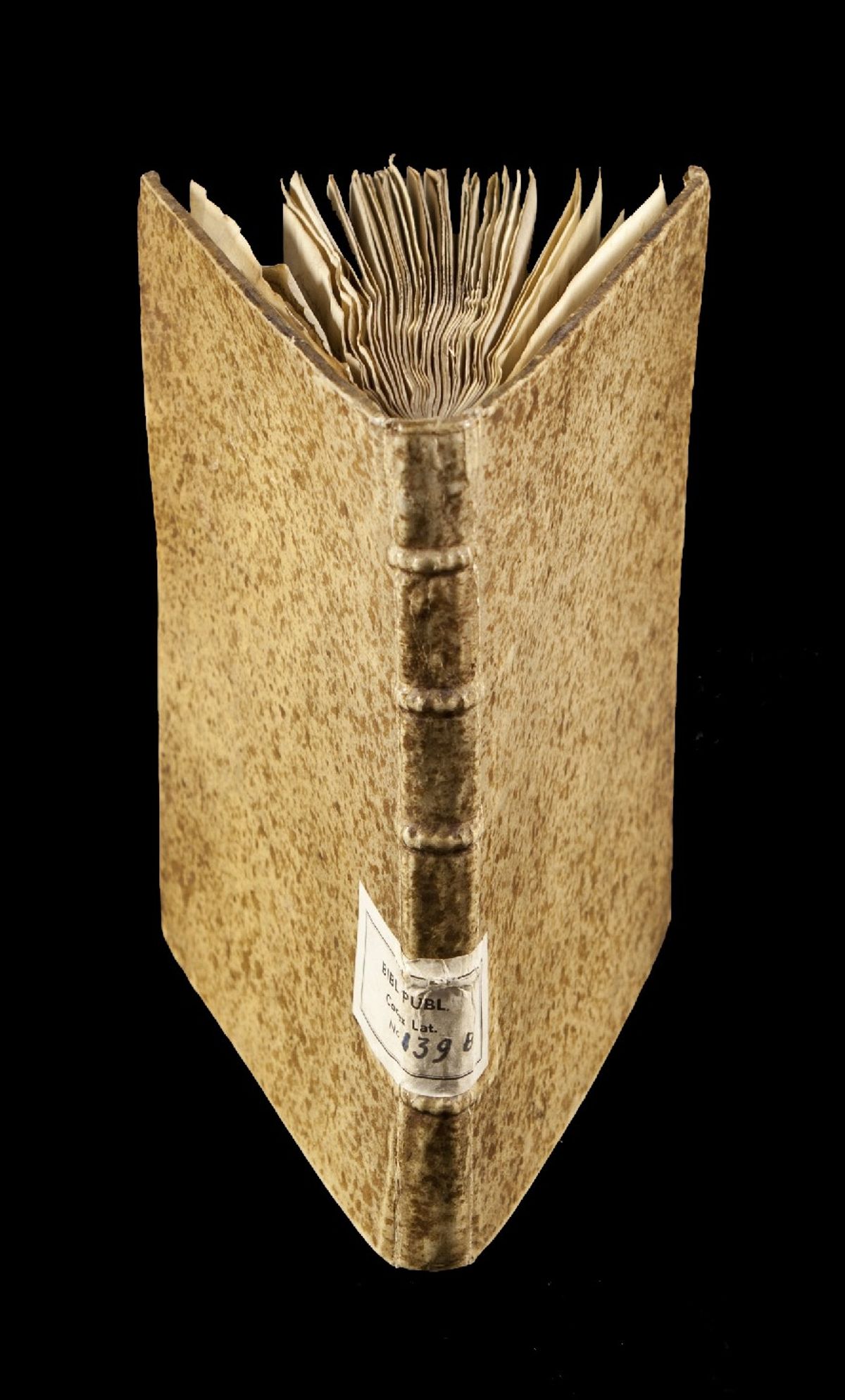

Where was it made?
All three parts of the manuscript originally belonged to the monastery of Fleury, at Saint-Benoît-sur-Loire in France. The monastery was dedicated to St Benedict of Nursia. On the last page of Leiden, UB, BPL 139B (f. 46v) we find a short religious poem. The first letter of each line refers to the saint’s name, spelling out ‘Sancte Benedicte'. Even in this logical textbook traces of the community’s devotion to St Benedict are evident.
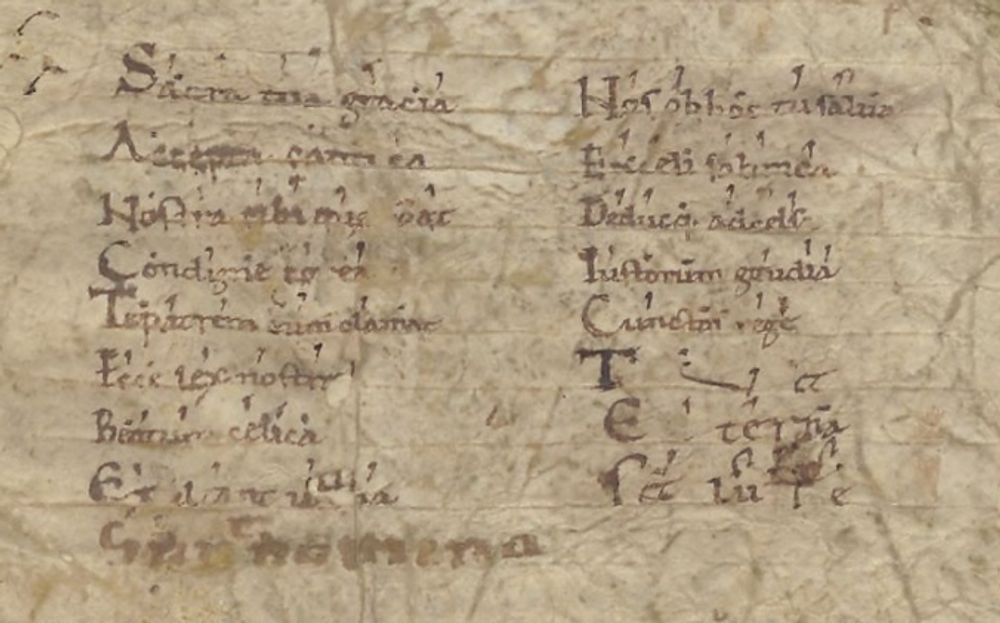
http://hdl.handle.net/1887.1/item:1687093
Not only does the manuscript contain some of the works of one of Fleury’s most famous intellectual figures, Abbo, but part of it is also written in the Fleury ‘house style’, a script used to write many of the manuscripts produced in this religious house in this period. Some typical features of this ‘house style’ include:


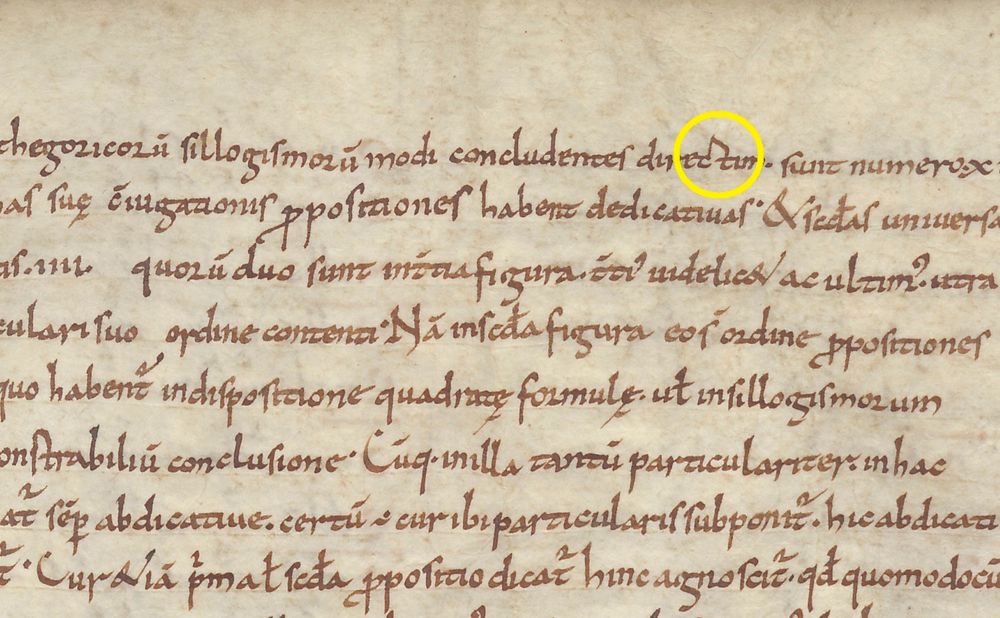

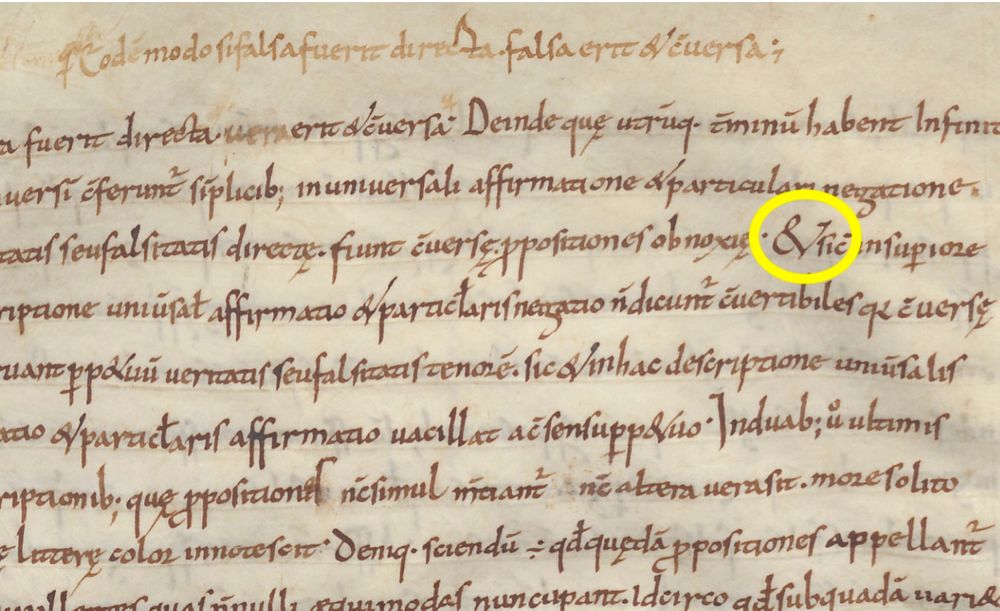

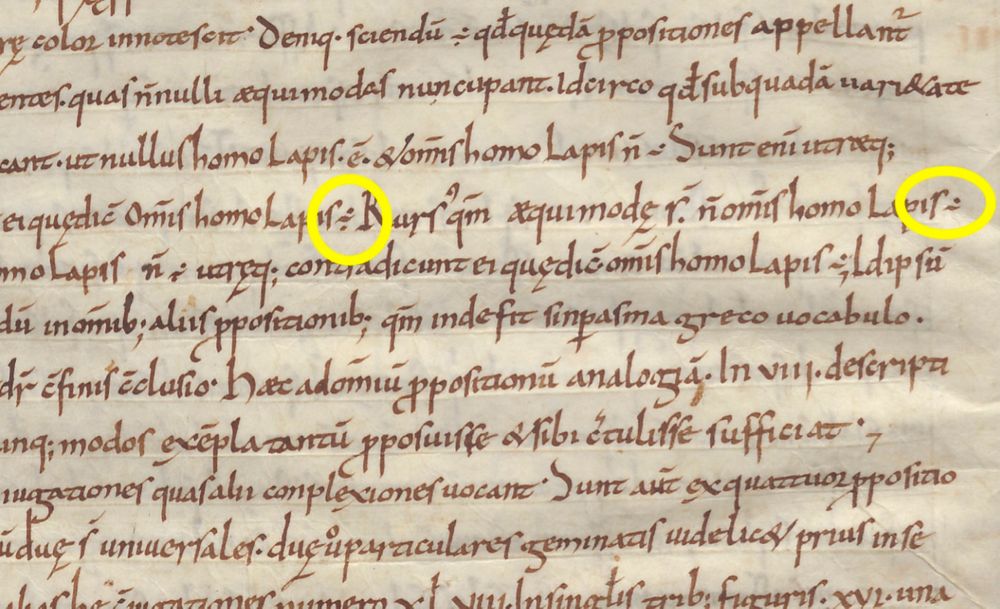

http://hdl.handle.net/1887.1/item:1687093
http://hdl.handle.net/1887.1/item:1687093
http://hdl.handle.net/1887.1/item:1687093
http://hdl.handle.net/1887.1/item:1687093
Abbo and the classical logical curriculum
Leiden, UB, BPL 139B opens (f. 1r) with a poem detailing the life of Boethius. Two of the works included in this manuscript – Abbo’s De syllogismis categoricis and De syllogismis hypotheticis – were inspired by Boethius’s logical works. Red majuscules are used here to indicate the start of new texts and also to highlight the first letter of each line of the poems, a decorative feature which also accentuated their poetic form.


Abbo’s writings mediate and consolidate the classical logical corpus for a medieval monastic audience. We can see one feature of his attempt on f. 2v; here two ‘squares of opposition’ are placed side-by-side to illustrate the differences between the approach of Aristotle (on the left) and Apuleius (on the right). Structurally the squares are similar, but different terminology is used by both authors to express relationships between propositions; for example, ‘incongruae’, ‘inconsistents’, is used by Apuleius in lieu of the more common ‘contrariae’, ‘contraries’, found in Latin translations of Aristotle.
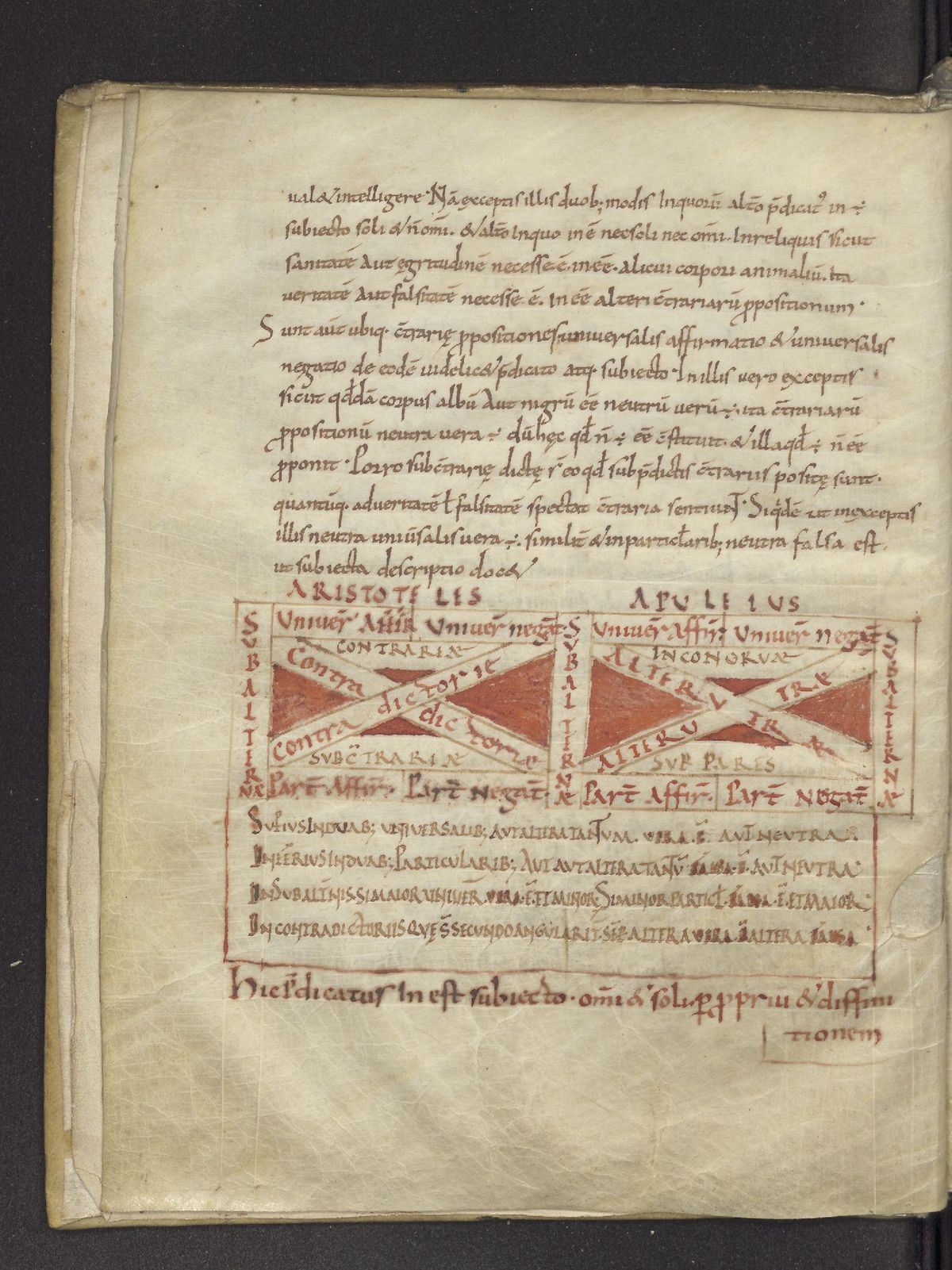

A striking feature of Abbo’s two texts on the syllogism is the number of sketched ‘squares’ of oppositional propositions found throughout. Abbo’s goal, as Ian Wilks suggests, ‘seems to be to exemplify all interesting conceptual possibilities for how the square may be instantiated.’2
The three opening propositions on this page (f. 3r) are:
“All men are able to laugh”: “Omnis homo risibilis est”
“All men are animals”: “Omnis homo animalis est”
“All men are musical”: “Omnis homo musicus est”
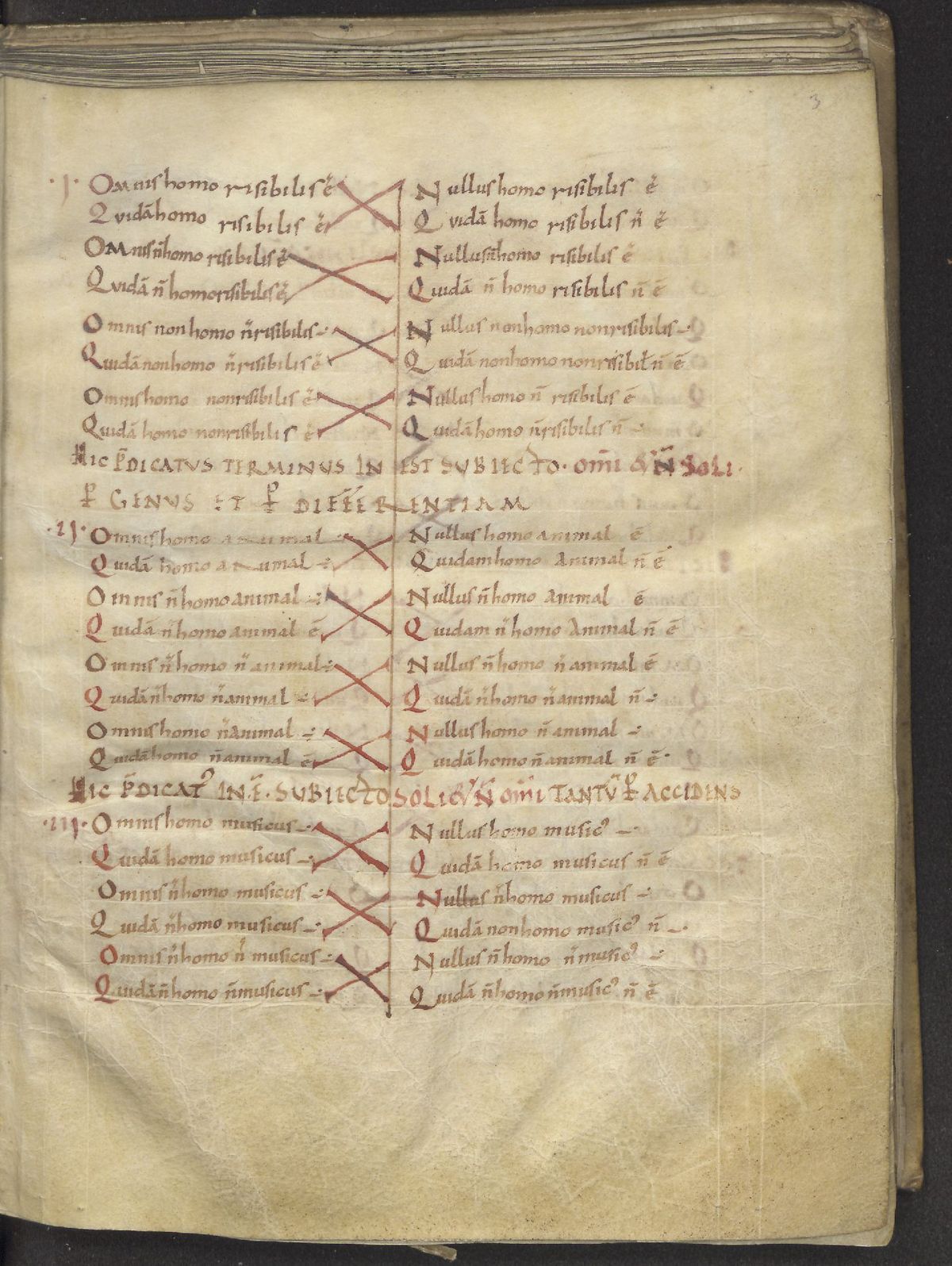

We can imagine that this proposition, derived from Cicero’s De inventione, I.29.44 (f. 28v) may have resulted in lively debate among a Christian audience who believed in the virgin birth of Jesus: “Si peperit, cum viro concubit”, “If she gave birth to a child, she had sex with a man”.


http://hdl.handle.net/1887.1/item:1687093
Imagining a student readership:
The various series of propositions can’t have been easy for a student to remember. Here on f. 8r we can see that labelling – ‘a’, ‘b’, ‘c’ – has been added between the lines to the various propositions to differentiate subject from predicate, and to demonstrate the shift in meaning of a word from predicate in one instance to subject in the next. For example, the first two lines of the first column read: “All virtue is good. All that is good is useful.” (“Omnis virtus bonum est. Omne bonum utile est.”) ‘Good’ is labelled ‘b’ in both propositions; ‘virtuous’, ‘a’; ‘useful’, ‘c’. Applying the principles of syllogistic reasoning (if a is b, and b is c, then a is c), this labelling would help a student to conclude that ‘All virtue is useful’.
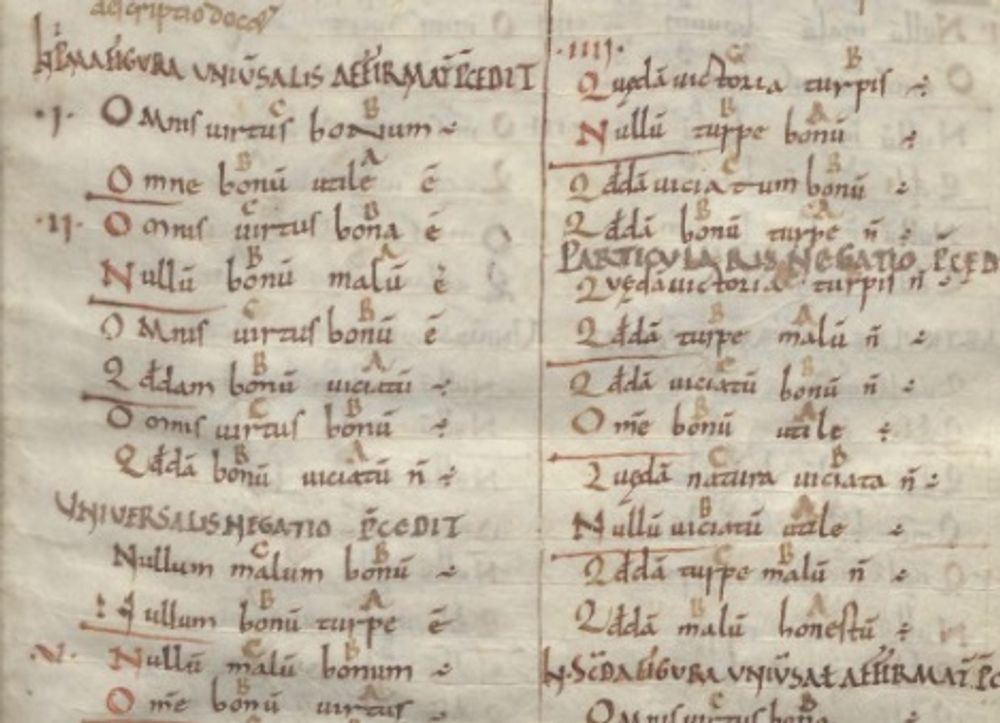
http://hdl.handle.net/1887.1/item:1687093
Apuleius’ Peri hermenias
As well as being influenced by the writings of Boethius, Abbo’s works on syllogisms also drew on the Peri hermenias, a short logical text attributed to Apuleius. This text is found in the second section of BPL 139 B (ff. 32r-39v). Elaborate initials depicting fantastical beasts were added at the opening of this text (f. 32r), and to indicate a new section (f. 36r).
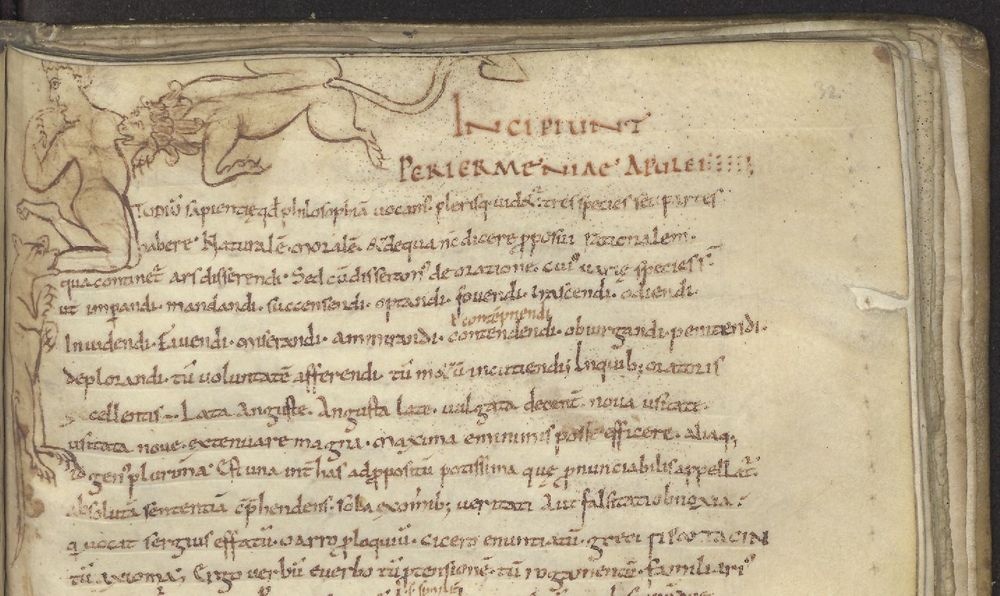

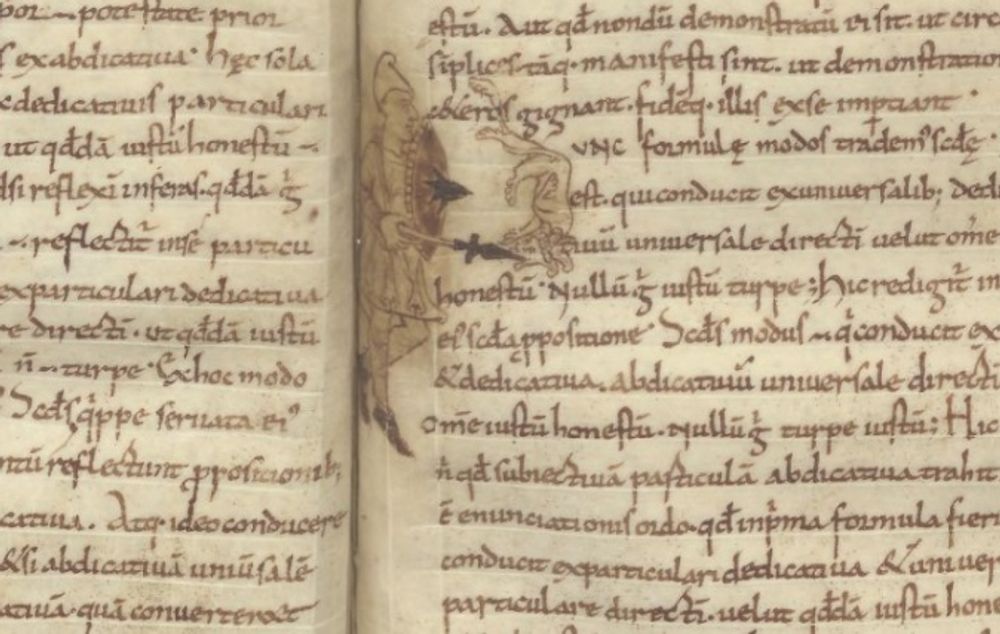

http://hdl.handle.net/1887.1/item:1687093
http://hdl.handle.net/1887.1/item:1687093
Apuleius was regarded as the originator of the square of opposition; an example of the square is placed within the text on f. 33v.

http://hdl.handle.net/1887.1/item:1687093
At the conclusion of the section of the manuscript containing Apuleius’ Peri hermenias (f. 39v), we find a ‘wheel of syllogisms’, an alternate means of representing the relationship between propositions to the square of opposition. To find out more about this ‘wheel’ see Reasoning through Syllogisms.
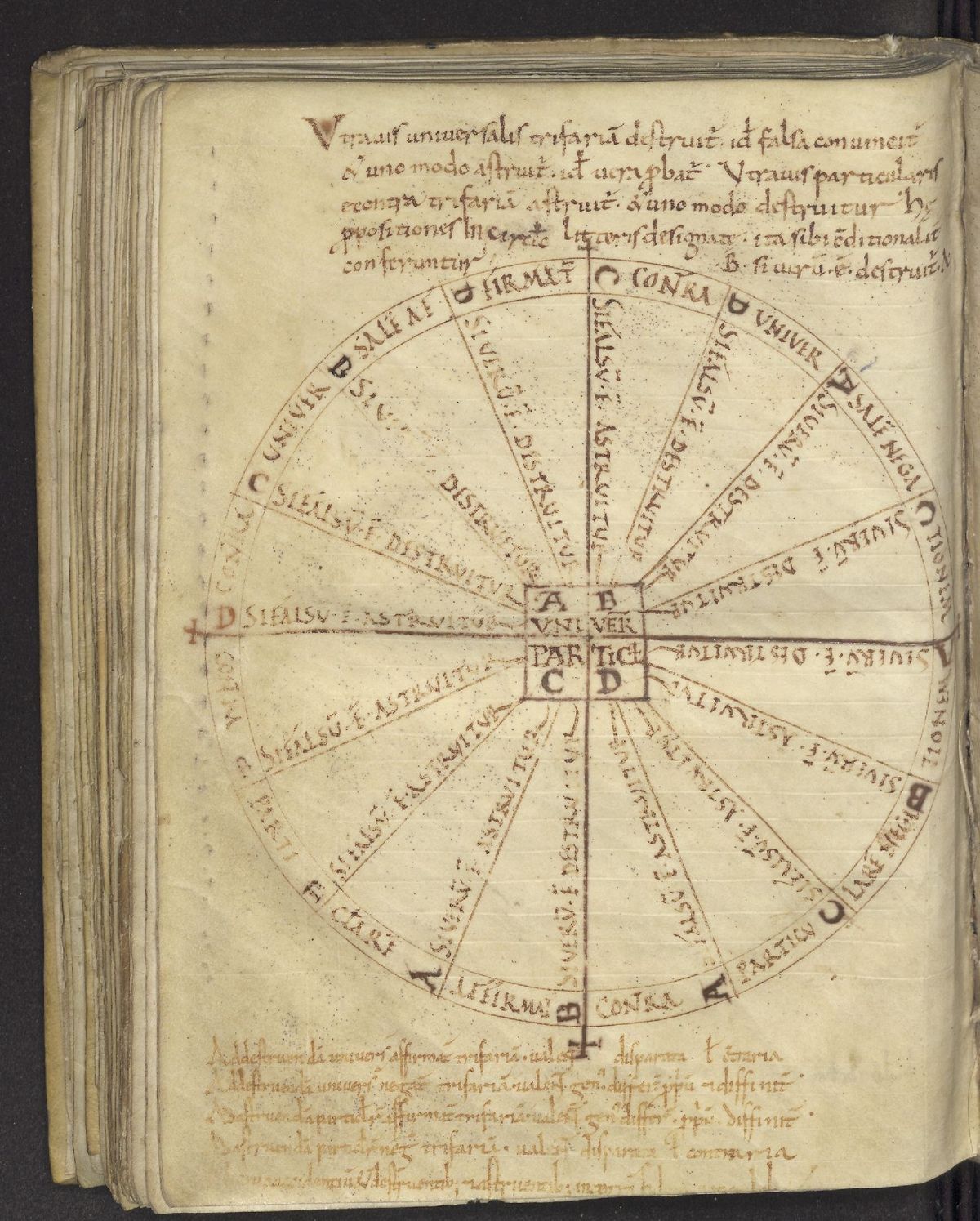

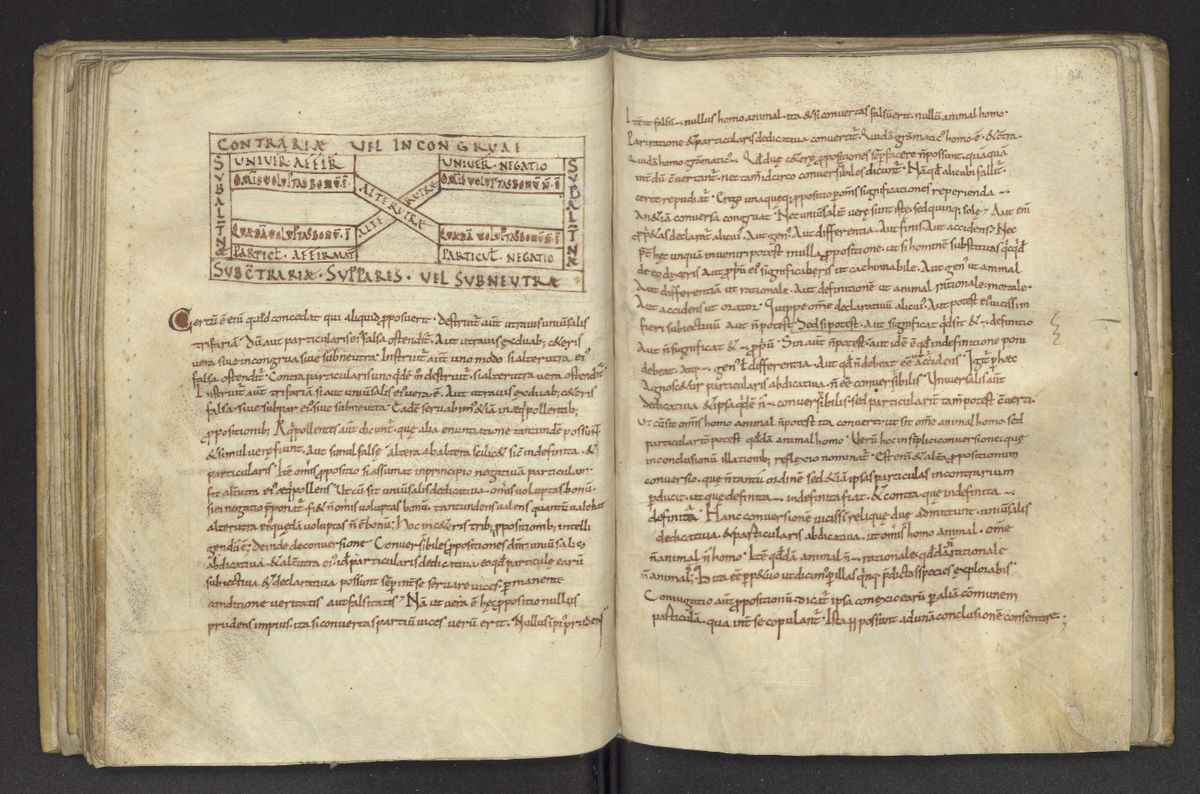

Porphyry’s Isagoge
The final section of BPL 139 B (ff. 40r-45v) contains Porphyry’s Isagoge, an essential work for medieval logicians. This part of the manuscript was written on particularly poor parchment. On f. 41 (see recto and verso views here), for example, we can see that the scribe has worked around a hole in the parchment.


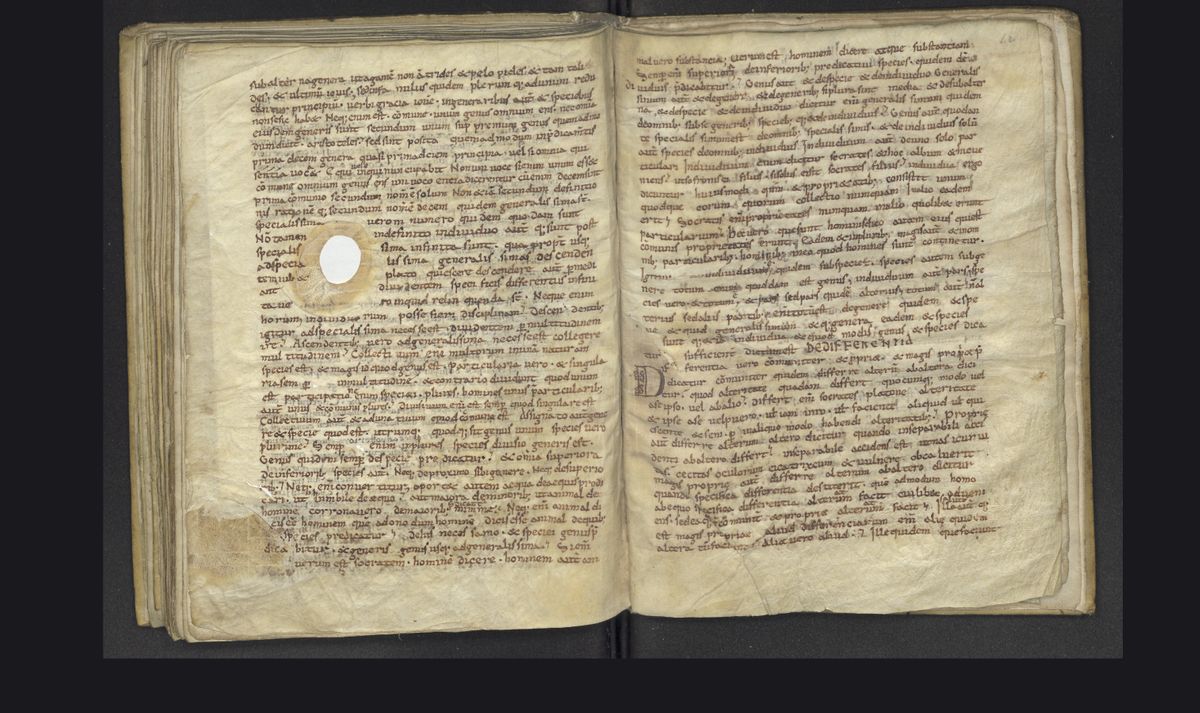

The parchment is not uniformly coloured, as we can see on f. 42r, which may point to how it was prepared or to the poor quality of the skin. At points the scribe has been unable to make his ink ‘take’ to the parchment, again indicative of its poor quality. These flaws suggest that this manuscript was intended for workaday use; its contents may have been canonical, but its production was economical.


http://hdl.handle.net/1887.1/item:1687093
The concluding page of the manuscript (f. 46r) contains a short grammatical note on the five Latin declensions. This note, intended to help the reader memorise the noun endings, was probably intended for teaching; this suggests that this copy of the Isagoge may have been a teacher’s manual, perhaps even a personal copy. One can only wonder if the sketch found beneath the text is of the teacher himself, or perhaps a self-portrait of a distracted later reader!


Sources used for this contribution:
- Gerritsen, W., Europa’s leerschool: de zeven vrije kunsten in de Middeleeuwen. Een rondgang langs Leidse handschriften (Leiden, Primavera Pers, 2007)
- Gumbert, J. P., Illustrated Inventory of Medieval Manuscripts in Latin Script in the Netherlands, vol. 2: Leiden, Universiteitsbibliotheek BPL (Hilversum, Verloren, 2009)
- Pellegrin, E., ‘Membra disiecta Floriacensia’, Bibliothèque de l’école des chartes, 117 (1959), 5-56
- Wilks, I., ‘Latin Logic up to 1200’ in The Cambridge Companion to Medieval Logic, eds C. Dutilh Novaes, S. Read (Cambridge, 2016), pp. 94-118
Contribution by Irene O’Daly.
Cite as, Irene O’Daly, “Leiden, UB, BPL 139B”, The art of reasoning in medieval manuscripts (Dec 2020), https://art-of-reasoning.huygens.knaw.nl/bpl139b. ↑
I. Wilks, ‘Latin Logic up to 1200’, The Cambridge Companion to Medieval Logic, (Cambridge, 2016), p. 101 ↑


